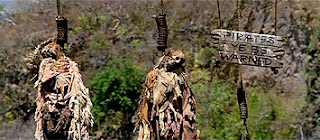The pirate MacGrath rowed into Dead Man’s Cove alone, with
muffled oars, under a sliver of moon no
wider than her finger-nail. It was slack tide, and the sea and the shore were
both eerily quiet. She whistled a little, under her breath, as she worked the
oars, for whistling kept ghosts at bay, and the place was known to be haunted.
Not that the man she had come to meet, the informant who was
supposed to tell her the sailing date of next year’s Spanish Treasure Fleet,
was likely to believe in ghosts. The English had no proper respect for spirits.
It was an English trait to think themselves a match for anything, and anyone.
Scarlet MacGrath, the pirate, crossed herself and shivered. The Irish knew
better.
As she came around the headlands, the bulk of a ruined
castle rose up to the north. Henry Morgan,
they said, had taken the place, forty years ago. He had sacked the nearby town,
let loose his bloody-handed men to work their will upon the helpless
townspeople, then burned it all and killed anyone left standing. Men had called
it “war” back in the old days. Now they called it “piracy” and hanged the
perpetrators. Morgan, if she recalled,
had been knighted.
Now the place was a shambles, and even the stubborn, lordly
Spanish had not cared to come into the ruins, even to rebuild.
Scarlet kept rowing until she felt the hull of her little craft
first brush sand, then glanced over her shoulder and picked a spot to beach the
boat. Her man was coming over the nearby ridge, on the old silver-hauling
track. Damn fool had set his time by the clock, a landsman’s silly conceit.
Midnight, a fool’s time.
In an hour the tide would come in, and she would be trapped
here for six hours, until the moon pulled the water back out to sea, and her
little boat could breast the moving water again.
She leaped out once the bow touched, her boots splashing through
the lukewarm salt water. The sound was loud in her ears. Then threw the oars
into the boat and pulled out a lantern, shuttered so it would not yet reveal
its light. The boat scraped loudly on the rocky shore.
With the boat secure, she began her climb up to the castle. It
looked like an Old-World thing, the black stone barely visible against the
black sky, crenelated walls and broken towers, and a soft sound of movement
within, as the Caribbean jungle closed in around the human remains.
Her contact had said the inner courtyard, as if by hiding
inside a ruined building inside a ruined city and under a dark sky, he could hide
his sin. He was a sinner, sure. He’s promised to betray the Spanish who employed
him. Now he was lurking in the dark, waiting for a pirate. Well, the pirate was
a sinner, too. But not a stupid one. Scarlet opened the shutters on her lantern,
and the candle within gave forth its feeble glow.
At least now she could see the path. Old bones lay along the
narrow way – the dead, never buried slipped under her feet in the dark. Scarlet
tilted the bottle back again. The emptiness of the pierced into her, dug into her
heart. She was here for gold, gold that
would buy freedom from the laws of the world, from the English and their
governors and their bloody navy. Enough gold could buy anything.
A Spanish
treasure ship would be just about enough. Bones, she had seen before.
Some animal scuttled through the dark. Scarlet felt her
heart stumble. She wanted the pistol that was secreted in her coat pocket. But
taking it up meant dropping the bottle or the lantern. She wanted both. She
waited until her heart steadied, then went on.
The castle gate had been blasted open buy cannon fire. Great
broken stones lay scattered like dice cast by a giant’s hand. This was Morgan’s
work, and the remains of the dead lay again among the stones. The words of the Rosary
came to Scarlet’s lips, and she crossed herself with the hand holding the
whiskey bottle. The light from her lantern danced and shivered. Ahead lay the
dark tunnel of the gate.
She must spend some time breathing before she entered that.
It was like going down the mouth of a haunt. How she wished she that she had a
bit of rowen wood, to turn the evil spirits. But the only rowen was many miles
away. She had light and drink and a pistol in her pocket. And friends, good
friends waiting for her back on the ship, with beer and tobacco, and a bit of a
fire in the ship’s galley to ward off the evening chill.
The lantern-light seemed to increase in the narrow passage, until
her eyes were dazzled. A shadow moved behind her. She turned, holding the
lantern high. But it was only her own shadow. Scarlet opened the shutters on
the lantern clumsy as she still held the bottle, and went on.
A sharp, cold wind hit her when she stepped out of the
tunnel, and the candle in her lantern guttered.
Swearing, she dropped to her
knees, fumbled in her pocket, past the gun, to a tinder box with flint and
steel. She struck, and struck again and again trying to shield the candle with
her body, but the space was too open, the wind too fresh.
She groped forward then, on hands and knees, seeking a
sheltered place. Damn the spy! He should have come by now. Should have had his
own light. He was the one who had insisted on this haunted place. Could it be a
trap? Could he be waiting with a friend or two, to catch her up? There was a
bounty on her head in Spain.
But that was madness. This place was boneyard, a slaughterhouse,
a haunted cemetery. No sane
man would come to such a place.
Shoving the bottle into her pocket, she scrambled to her
feet and stumbled toward the tunnel. For two steps she was all right but then
she tripped and went down again, dropping the lantern, which shattered with a
crash. She was on her hands and knees, in the dark, with the wind moaning
around her and the bodies of the dead under her hands.
For too long, Scarlet crawled about like a mad thing, her
skirts tangled under her and her hands cut by the glass of the shattered lantern.
The cool of the night had settled in, and a fine clammy mist had settled into
the castle’s courtyard. The rocks were slick with it.
She lurched to her feet, arms reaching out, and blundered
alongside a skeletal tree. Some sort of mass hung in it, perhaps a downed flag
or a piece of rotting curtain blown down by the wind. But her hand touched
something soft and warm. Her hand knew, before her mind did, and a long, long shudder
rant through her body. It was a body, a human body. A man, in a decent coat (by
the feel of the wool) and he was going cold.
The horror of the hanged man knocked her backwards. She had
feared hanging half her life. Her eyes locked onto the body, swaying in the
breeze, the faint light of the moon gradually revealing the white face, staring
eyes, the hands still clutching at the leather belt wrapped around the throat.
She had not expected hanging.
A great tiredness came over her. Alone in this desolate place, alone with the
dead.
A prickling came along her back, as if she was being
watched. The cold mists seemed to coalesce. She saw faces. The place was full
of bones. The words of her prayers choked in her throat. The damned Englishman
had come here, and had died here, and she had been lured in, and would die
beside him, of whatever had brought him down.
The misty forms came closer. Skeletal hands reached out,
crawling across the ground. Eyes glowed in the darkness.
She had expected screams from them. But she heard murmurs
instead. No threats. No rage. Only pain and loss that reached out to her own loneliness.
She felt them. The cold of them. Their hunger and thirst. Especially the great,
great thirst that the dead feel.
A hand plucked at her ankle and she pulled away. Another
form of mist `crept closer. All along
the ground were the bones of the slain.
She could escape. She could climb up the rotting tree. She
could get above them. She could wait them out until sunrise, and then go back to
her little boat, and row it out into the friendly see, and to her ship and her
crew who would welcome her and her surround her with their comradeship and
their good cheer.
The misty, skeletal hands clutched at her ankles, plucked at
her skirts.
She would not go up the dead tree. She would not go up with
the dead man, and die as he had died, by misadventure or by an excess of terror
or a shortage or friends, he the traitor had died.
But she did not lack for hope or friends. She lacked only
gold, and was the Irish who knew that gold could be lived without. The spectral
figures clutched up to her knees, and she took the whiskey bottle from her
pocket and shouted “Drinks on the house!” then threw it with all her might.
She ran to the shore, falling over rocks and into holes. She
did not look back.
***
If you enjoyed the story of Scarlet MacGrath the pirate, check out more of her story. Available on Amazon. https://www.amazon.com/TS-Rhodes/e/B00FD66IL6
































